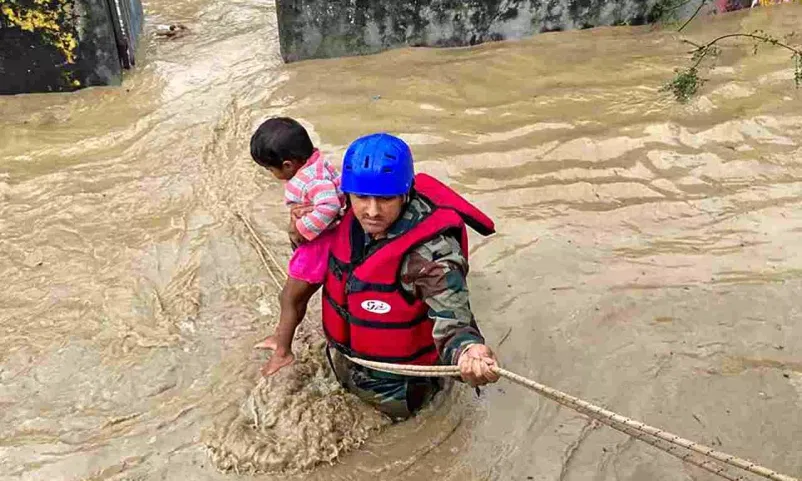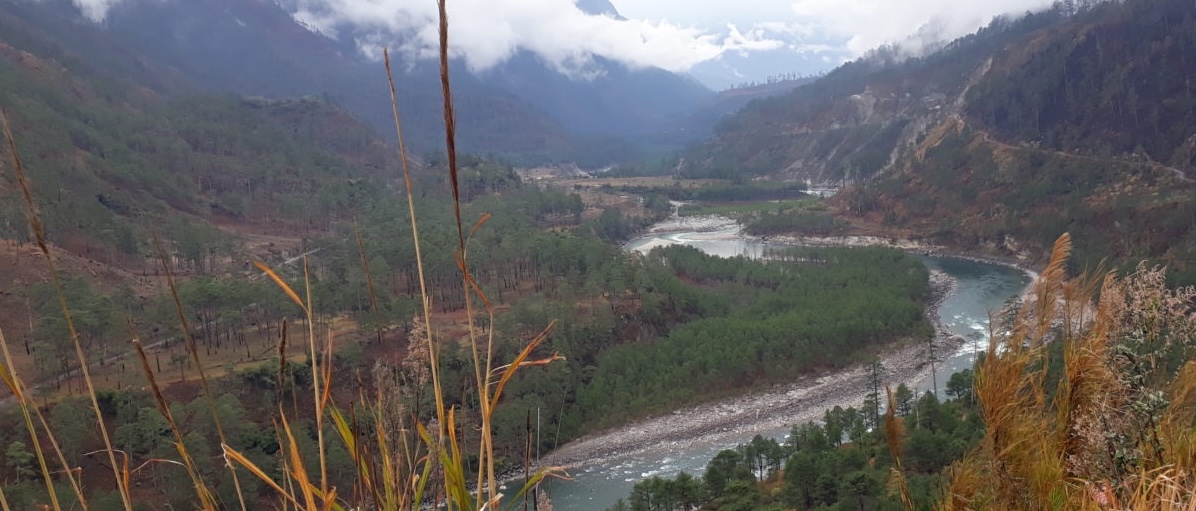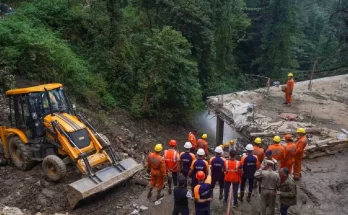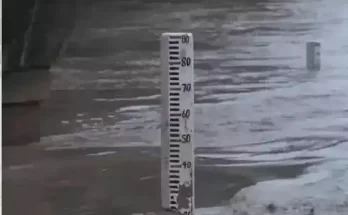There is still no cap on the number of tourists and pilgrims thronging the Himalayan state.

An Indian Army jawan rescues a child stranded in flood water in Tanakpur of Uttarakhand. (Photo credit: PTI)
New Delhi: On the morning of June 18, 2013, when a helicopter reached near Rambada at the base of the holy Kedarnath shrine, the pilots couldn’t believe what they saw below.
Rambada was the buzzing pit stop for pilgrims headed towards and coming back from Kedarnath, one of the important stops of the Char Dham Yatra. On any given day during the Char Dham Yatra season, the place was chaotic with over 10-15,000 people – some of them headed towards Kedarnath, some going to the next destination; some of them rest house / hotel and restaurant owners, porters, pony wallahs, labourers, drivers, home guards, local police etc.
It had been raining for about a week but June 16 and 17 were especially crucial when there was a cloudburst followed by massive rainfall leading to disastrous floods. On the evening of June 16, Rambada was washed away while next morning, Kedarnath bore the brunt after the glacial lake fed by Chorabari glacier burst leading to wiping out of the Kedarnath township.
On the morning of June 18, when the helicopter was pressed into service, especially to find out the extent of damage, the pilots saw Rambada washed away with signs of destruction and death everywhere. Th rest, as they say, is history.
The intervening night of June 16 and 17 had witnessed the worst disaster in the fragile Himalayan state of Uttarakhand that is home to four most prominent pilgrim places drawing lakhs of people every year. Official estimates mention about 9,000 people died in that disaster – unofficially, local people say, it is more than 15,000 – which had made its mark not just at Kedarnath but across several places.
The humongous floods had swept away buildings, hotels, ate into roads and townships and caused damage to property worth lakhs of rupees along the Ganga and other main rivers.
10 years later, nothing has changed
Ten years to the date of the anniversary of the tragedy, nothing seems to have changed. As many as nine helicopter companies operate helicopter-sorties from Sirsa, Phata, Guptakashi along with Dehradun and Uttarkashi too to Kedarnath totalling to almost 250 a day. In fact, statistics showed that 10% of the pilgrims visiting Kedarnath used heli-sorties.
It is a result of the astronomical increase in the number of tourists and pilgrims to the Himalayan state. The number of tourists visiting Uttarakhand has consistently increased from around 22 million in 2014 to around 39 million in 2019, and registered a CAGR of 11.97%.
Said Anoop Nautiyal from Dehradun-based think tank Social Development for Communities Foundation (SDCF) said, “These heli-sorties are increasing by the day. There are so many, they are operating as if three-wheelers on Chandni Chowk main road.”
These hundreds of sorties every day are environmentally harmful for the pristine valley, he said and pointed out: “But more than that, these also have the capacity to add to the disaster with the continuous emissions, loud noise that can destabilise glaciers / snow on the hills etc.”
Mallica Bhanot, member of Ganga Ahvaan, Uttarakhand-based citizen forum working towards cultural and environmental conservation of the Ganga basin, pointed out: “In 10 years, the Uttarakhand government should have made stricter regulations for tourist numbers and the number of people coming for pilgrimage. Contrarily, the Uttarakhand government has arbitrarily increased the carrying capacity and has been pushing for unregulated tourism.”
Said Nautiyal, “Not just the government has not taken any concrete steps towards it, in fact, the carrying capacity figures too have varied from time to time. For instance, in 2022, the government first announced that the daily carrying capacity of all four dhams should be 38,000 but within 10 days, they increased it to 42,000. In all, as high as 45 lakh pilgrims visited Uttarakhand in 2022.”
“The mindset of having record tourists/pilgrims is a totally immature approach and can prove fatal,” he said, adding, “The road map for disaster management needs to have a holistic approach just as they have done in Odisha.”
“Disaster is not at all the priority of the government,” rued Anil Joshi of non-profit Himalayan Environmental Studies and Conservation Organization (HESCO) as he gave examples of Raini (where in February 2021 a large glacial burst led to flash floods killing more than 200 people and washed away an under-construction hydropower station) and Joshimath, where for the past year, an entire colony is facing land subsidence).
Apart from the district magistrates who have been given charge of the districts disaster management, Joshi said, the immediate few hours after a disaster are the most crucial. “There are primary schoolteachers in almost all villages and they are mostly the local people. Why can’t the government rope them in as the front line responder?” he suggested.
Said a Uttarakhand government official, on condition of anonymity, “Tourism is crucial for a hill economy. So, even if the government thinks, there actually cannot be a cap on the number of visitors. Moreover, the lobby of priests, pandas, pony wallahs, hotels etc. Too don’t want this to happen as they earn huge profits during the Char Dham Yatra season.”
A 2018 study, ‘Strategic Plan for Risk Reduction – Tourism Hotspots of Joshimath and Badrinath’ mentions that a survey of four towns preceding Joshimath (Ratura, Gauchar, Nandprayag and Chamoli) which are also on the Badrinath route found that as many as 57.5% of the households were engaged in tourism services with 37.5% amongst these exclusively engaged in tourism services (the rest partially or fully engaged in agriculture).”
“Also, those engaged in tourism services were able to earn higher incomes than those engaged in agriculture. These data are indicative of the scenario in the towns from Joshimath to Badrinath where the economic dependence on tourism is in fact higher,” it said.
Calling for “ecology inclusive economy,” Joshi said, “Tourism plays an important source of livelihood. Local involvement is most important for any decision. There has to be a decision about carrying capacity but that needs more awareness.”
Some of the positive steps that have been taken are just too small. “Linking local livelihood with environment protection can bring about the change. For instance, a team of locals can keep check on what pilgrims carry to the hills. Upon their entry, all chip packets and plastic bottles can be taken away. Instead, the pilgrims and tourists can provide snacks and food prepared by locals from local grains,” he said.
Since the last five years, HESCO has already started the ‘Anaj Prashad Ban Jaye’ scheme wherein local women SHGs prepare laddus from local grains and it is offered as prasad at Badrinath and Kedarnath.
In 2013, a major reason for loss of and damage to property was the role of illegal construction, many times in the river bed. “Uttarakhand government should have cleared all the encroachments along the river and should have regulated construction in the valleys. Contrarily, the state has had Char Dham road widening project and Char Dham railways project being constructed simultaneously with hydro power projects, increasing unregulated tourism, helicopter tourism etc. This has led to deterioration of the local ecology,” Bhanot said.
Tourism Policy 2023
Recently the Uttarakhand government has proposed ‘Uttarakhand Tourism Policy 2023’ which envisages to chalk out “a sustainable development strategy for tourism sector in the state.”
It envisages a big role for the private sector for services such as accommodation, tourist facilitation, transportation, organization of tours, activities, events, etc. while the role of the state government and its departments would revolve around policy, regulation and promotion of tourism.
To the dread of the environmentalists, it talks of unleashing Uttarakhand’s latent potential as a diversified tourist destination, offering a mix of heritage, religion, nature, wildlife, health, wellness tourism and more; promoting Uttarakhand as an all-weather destination – such as winter & Alpine tourism and achieving a higher length of stay among tourists.
Bhanot said, she has not read the full policy but considering the activities being promoted, it seems that the policy is not in tune with the fragility of the area and is not in sync with the reality on ground. “The government keeps introducing bizarre ideas such as river rafting in Harsil, paragliding in Tehri etc.; none of which are in sync with the current environmental status nor is in tune with the cultural sanctity of the state,” a disgusted Bhanot said.
(This story first appeared on news9live.com on Jun 01, 2023 and can be read here.)



